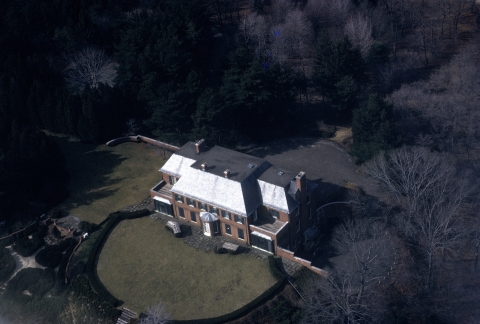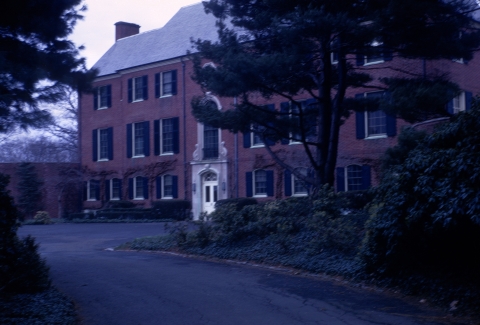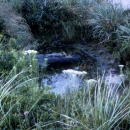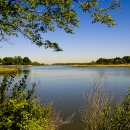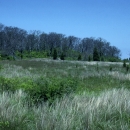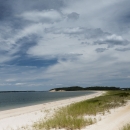About Us
Target Rock National Wildlife Refuge was acquired in 1967 as a donation from the Eberstadt family, who maintained the land as a garden estate. The 80-acre refuge is located on the north shore of Long Island in the Village of Lloyd Harbor, 25 miles east of New York City. Target Rock refuge consists of mature oak-hickory forest, a half-mile of rocky beach, a brackish pond and several vernal ponds. This refuge is open to the public and is an extremely popular shore fishing location.
Wetlands
Wetlands like the brackish pond provide important habitat to Long Island’s wildlife. Here, the tide from Huntington Bay floods this pond daily and mixes with the freshwater from the surrounding watershed. The result—a pond with salinity lower than that of the Bay, teeming with life from plants to birds, turtles, mammals, and fish.
Microscopic plants and animals inhabit the pond and serve as food for other invertebrates and small fish. Black ducks and other puddle ducks feed on the invertebrates and aquatic plants. Herons and egrets silently stalk the water’s edge preying on fish.
A ring of smooth cordgrass lines the pond. It’s roots are adapted to filter out excess salt from absorbed water, which is then secreted through leaf pores. As the land becomes drier, cordgrass gives way to hightide bush, a woody plant which produces distinctive white flowers in early autumn. Red cedar and other trees border the upland edge of the pond. The sun loving cedar bears bluish berries, providing food for robins, catbirds, mockingbirds, thrushes and others.
Our Mission
Vision
Long Island National Wildlife Refuge Complex will preserve, manage, and restore some of the last significant natural areas for wildlife habitat, ranging from coastal systems, to native grasslands to mature forests. These habitats, present in nine distinct units, will support threatened and endangered species in addition to hundreds of species of migratory birds and other wildlife within the Atlantic Flyway.
Located adjacent to the nation’s major media center, the Complex is an ideal setting to increase public awareness, understanding and support of the National Wildlife Refuge System. We recognize that success is dependent on the Complex becoming an integral part of the community. We will work together with partners and local communities to protect priority wildlife-dependent recreational and educational opportunities. Through the use of the best scientific information and active habitat management, we will contribute to the fulfilling of the mission of the National Wildlife Refuge System for future generations.
Refuge Purpose
Each unit of the National Wildlife Refuge System is established to serve a statutory purpose that targets the conservation of native species dependent on its lands and waters. All activities on those acres are reviewed for compatibility with this statutory purpose.
The purpose of Target Rock is as follows:
- “…for use as an inviolate sanctuary, or for any other management purpose, for migratory birds” (16 U.S.C. §715d).
Our History
The Eberstadts donated 80 acres of land in 1967 through the Migratory Bird Conservation Act. Prior to its acquisition, the Eberstadts took great pride in maintaining beautifully landscaped gardens characterized by groomed grass walks, award-winning rhododendron and exotic plants. Set behind these fabled gardens was a relatively modest estate home. While the home was torn down in 1995, footprints of the garden can still be seen.
Many of Target Rock's award-winning rhododendrons were relocated to the New York Botanical Garden in the early 1980s. Remnants of the Eberstadt estate's formal gardens can still be seen blooming in the refuge forests every spring.
Why Target Rock?
Today the refuge land serves as crucial habitat for a variety of plants and animals. So why the name Target Rock? If you take the path all the way to the beach overlooking Huntington Bay, you will see a large, 14-foot-tall rock in the water. Supposedly, the British Navy used the rock for target practice during the War of 1812. If you look closely, you may even see some blemishes from the bullets.
Other Facilities in this Complex
The Long Island National Wildlife Refuge Complex consists of seven national wildlife refuges, two refuge sub-units and one wildlife management area wildlife management area
For practical purposes, a wildlife management area is synonymous with a national wildlife refuge or a game preserve. There are nine wildlife management areas and one game preserve in the National Wildlife Refuge System.
Learn more about wildlife management area . Collectively, the ten units are approximately 6,500 acres in size. Each unit is unique and provides a wildlife oasis amongst Long Island’s urban settings essential for the livelihood of migratory birds, threatened and endangered species, fish and other wildlife. The strategic location of Long Island in the Long Island Pine Barrens & along the Atlantic Flyway make it an important nesting, wintering and migratory stop over area for hundreds of species of birds.

